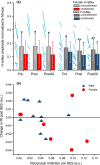Spinal excitability following sensory electrical stimulation of the upper limb
- PMID: 40969140
- PMCID: PMC12447001
- DOI: 10.14814/phy2.70520
Spinal excitability following sensory electrical stimulation of the upper limb
Abstract
The purpose of the study was to determine if sensory electrical stimulation (SES), below motor threshold, would reduce spinal excitability via reciprocal inhibition (RI) and determine if any changes were sex-related. Eighteen healthy participants (11 males and 7 females) participated in a pre-post comparison study. The Hoffmann (H-) reflex was elicited to assess the spinal excitability of Flexor Carpi Radialis (FCR) and the influence of RI from Extensor Carpi Radialis Longus (ECRL) on FCR using a paired conditioning pulse paradigm. A 15-min bout of SES (4 pulse bursts at 100 Hz) was applied to ECRL, and the H-reflexes were measured at 0- and 20-min post SES. A linear mixed model regression analysis was performed to evaluate the effects of stimulus order, conditioning, sex, and time on the FCR H-reflex. All participants experienced RI from the conditioning pulses, with females having significantly greater suppression than males (mean difference; MD = 0.026). For males, SES produced a depression in FCR excitability (MD = 0.023 at time 0; MD = 0.015 at 20 min post-SES) with no changes in RI. SES had no effect on FCR excitability or RI in females. The potential for SES to produce changes in antagonist excitability was sex-related, which may have important rehabilitation considerations.
Keywords: reciprocal inhibition; spinal excitability; upper limb.
© 2025 The Author(s). Physiological Reports published by Wiley Periodicals LLC on behalf of The Physiological Society and the American Physiological Society.
Conflict of interest statement
The authors have no real or perceived conflicts of interest to disclose relating to the work presented herein.
Figures






References
-
- Ansdell, P. , Brownstein, C. G. , Škarabot, J. , Hicks, K. M. , Howatson, G. , Thomas, K. , Hunter, S. K. , & Goodall, S. (2019). Sex differences in fatigability and recovery relative to the intensity–duration relationship. The Journal of Physiology, 597(23), 5577–5595. - PubMed
-
- Bergquist, A. J. , Clair, J. M. , Lagerquist, O. , Mang, C. S. , Okuma, Y. , & Collins, D. F. (2011). Neuromuscular electrical stimulation: Implications of the electrically evoked sensory volley. European Journal of Applied Physiology, 111(10), 2409–2426. - PubMed
-
- Burke, D. , Hallett, M. , Fuhr, P. , & Pierrot‐Deseilligny, E. (1999). H reflexes from the tibial and median nerves. The international federation of clinical neurophysiology. Electroencephalography and Clinical Neurophysiology. Supplement, 52, 259–262. - PubMed
MeSH terms
Grants and funding
LinkOut - more resources
Full Text Sources

